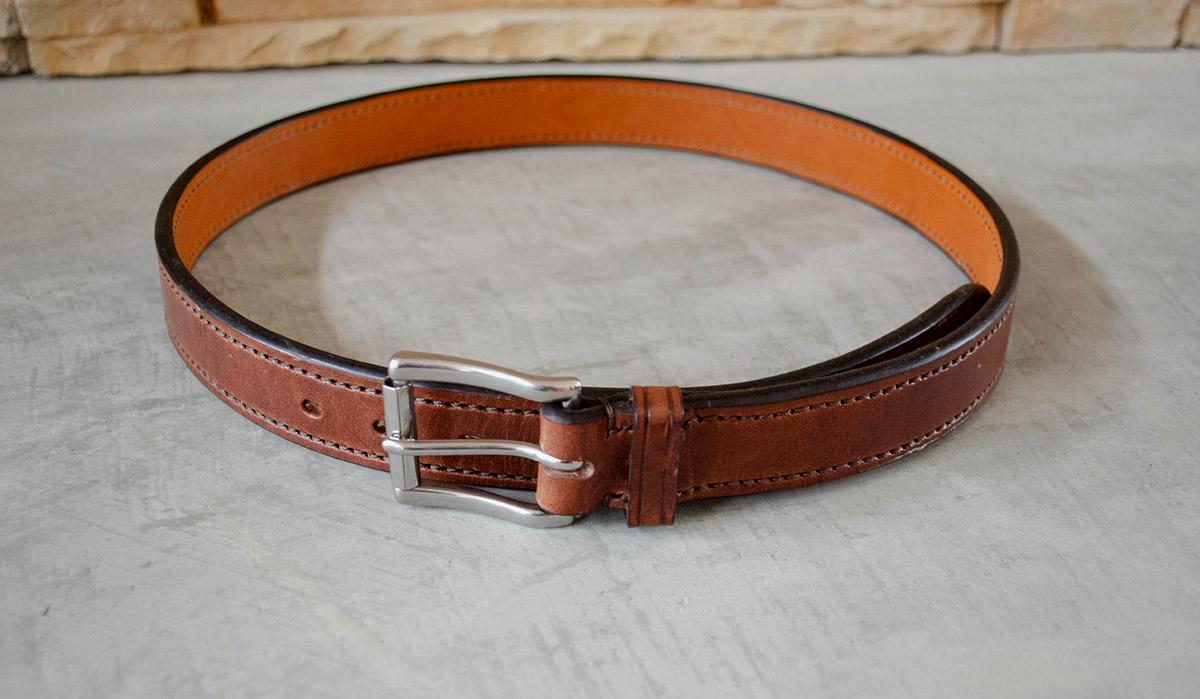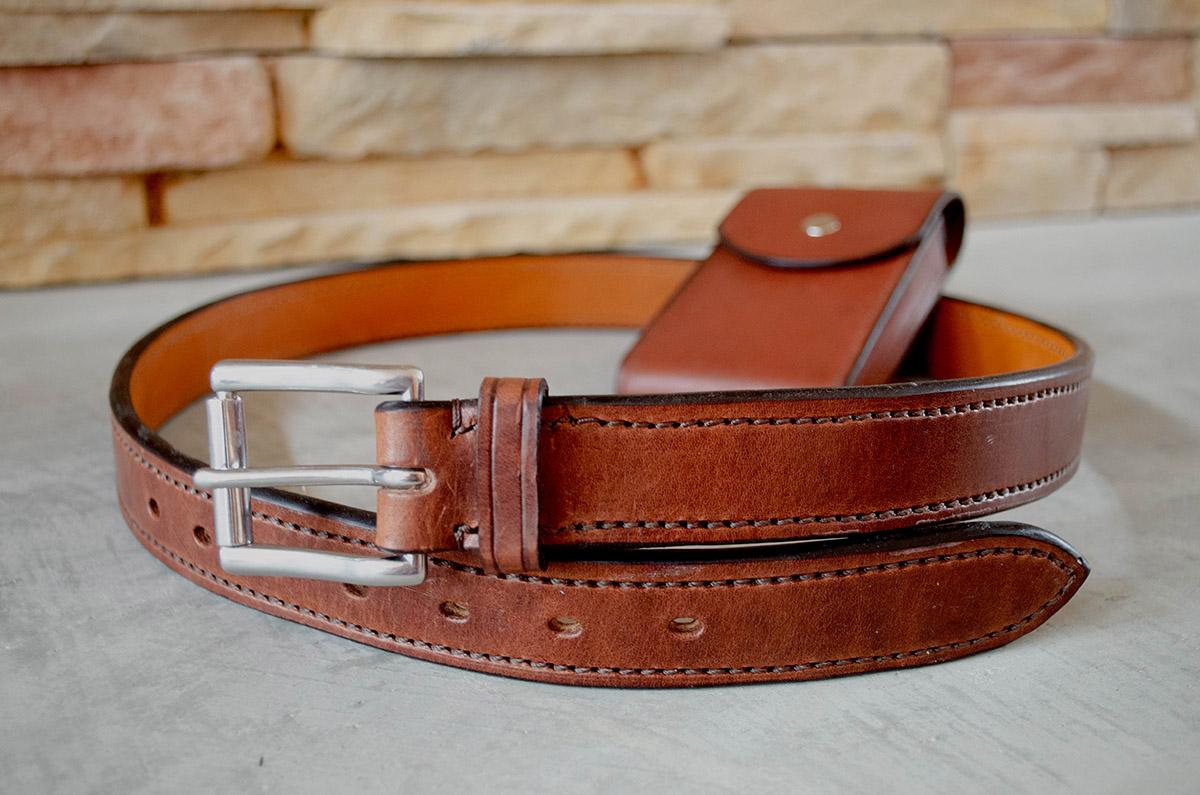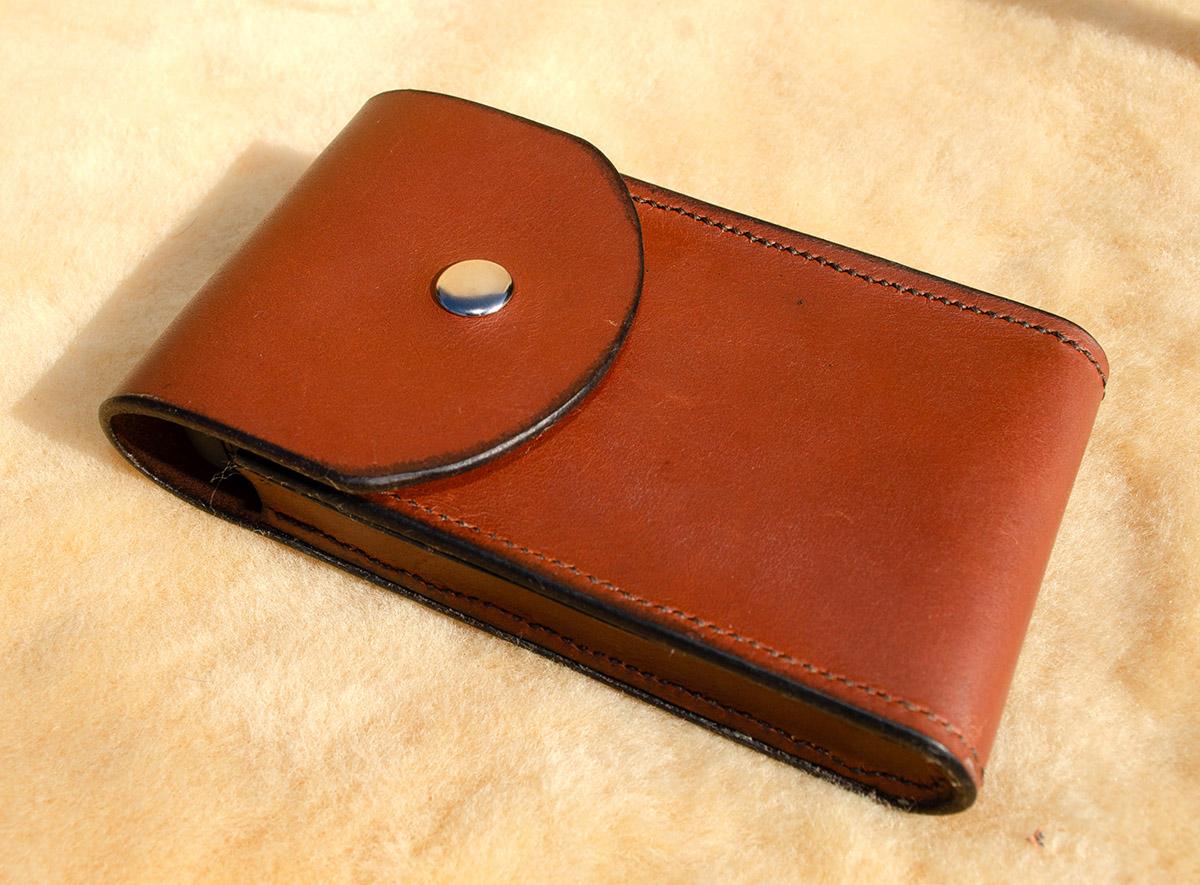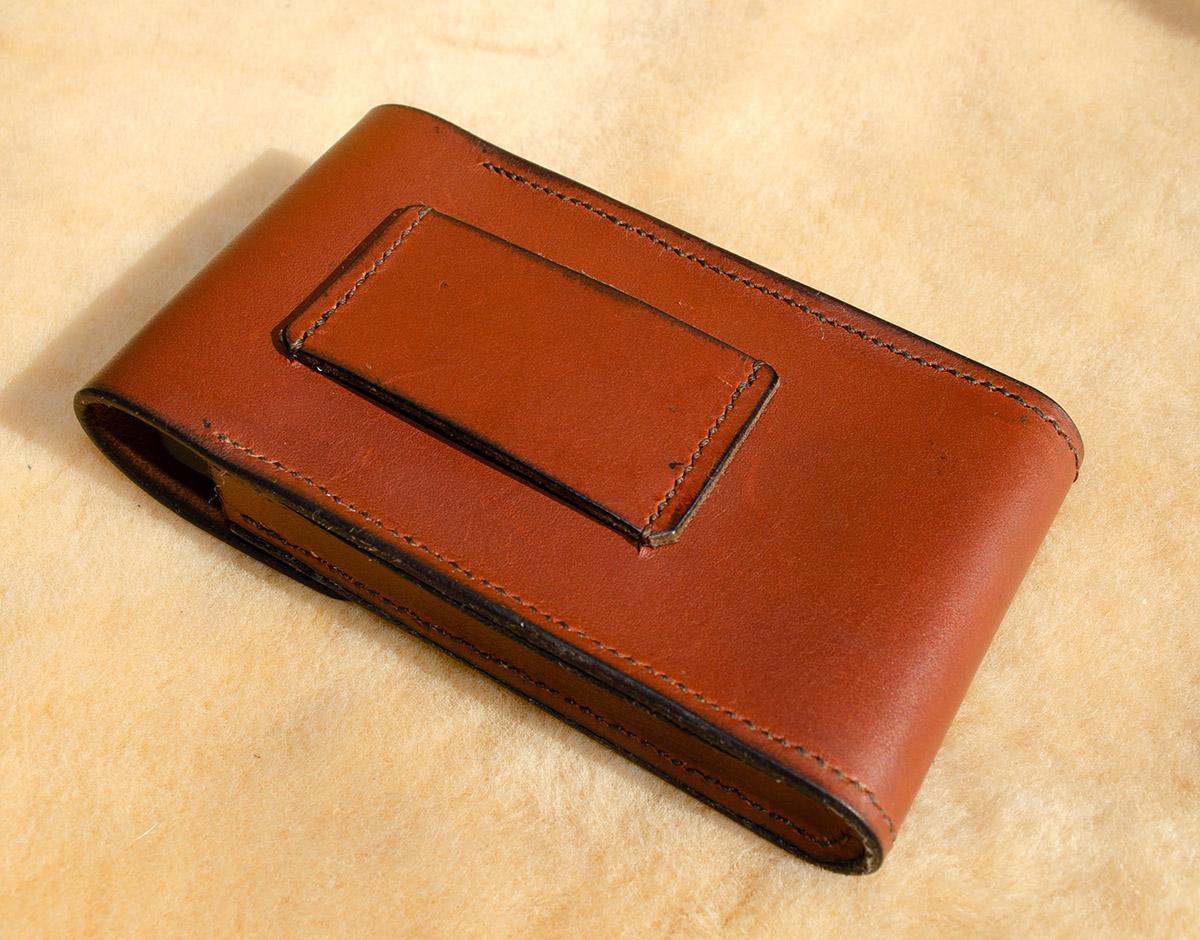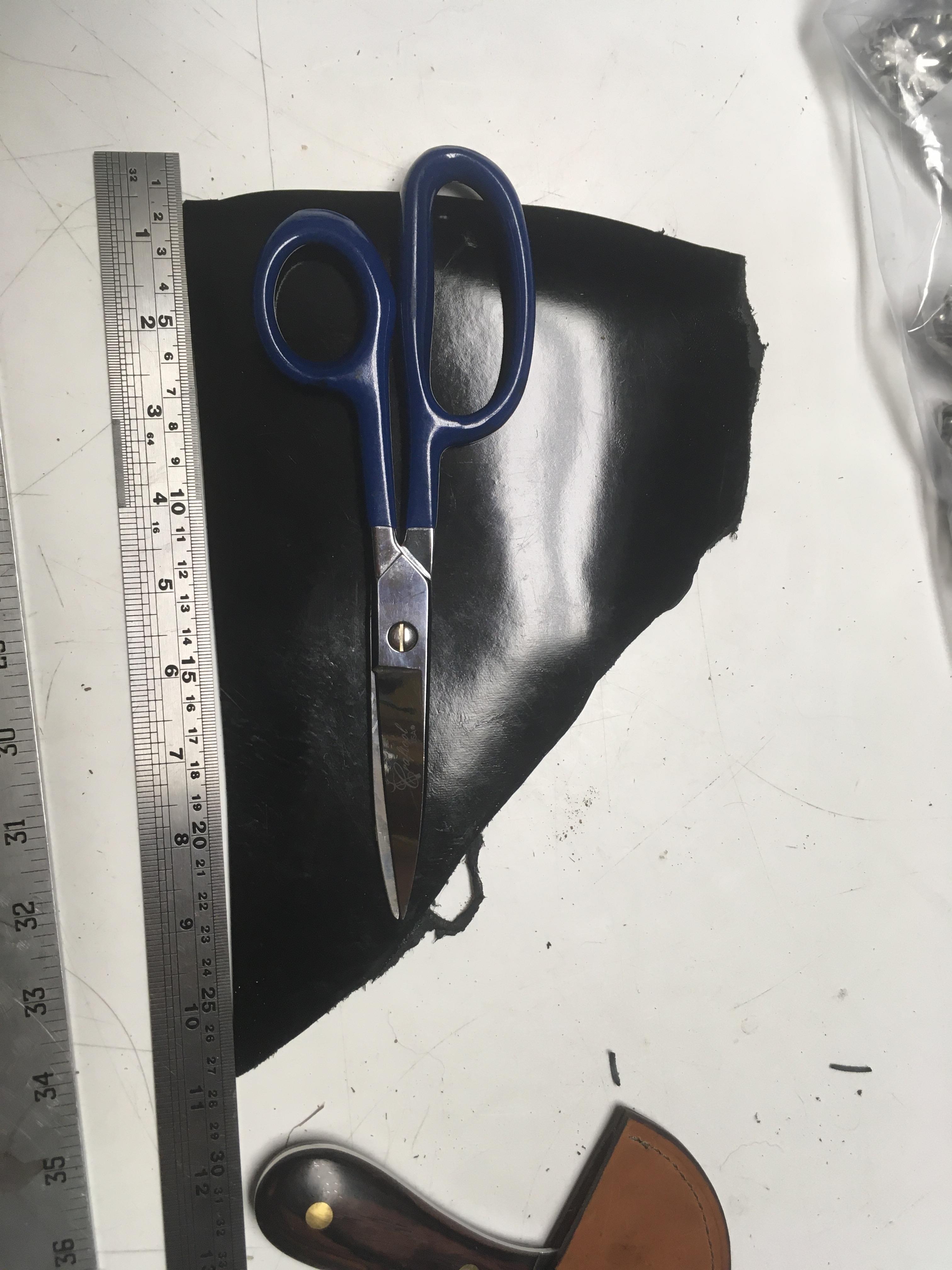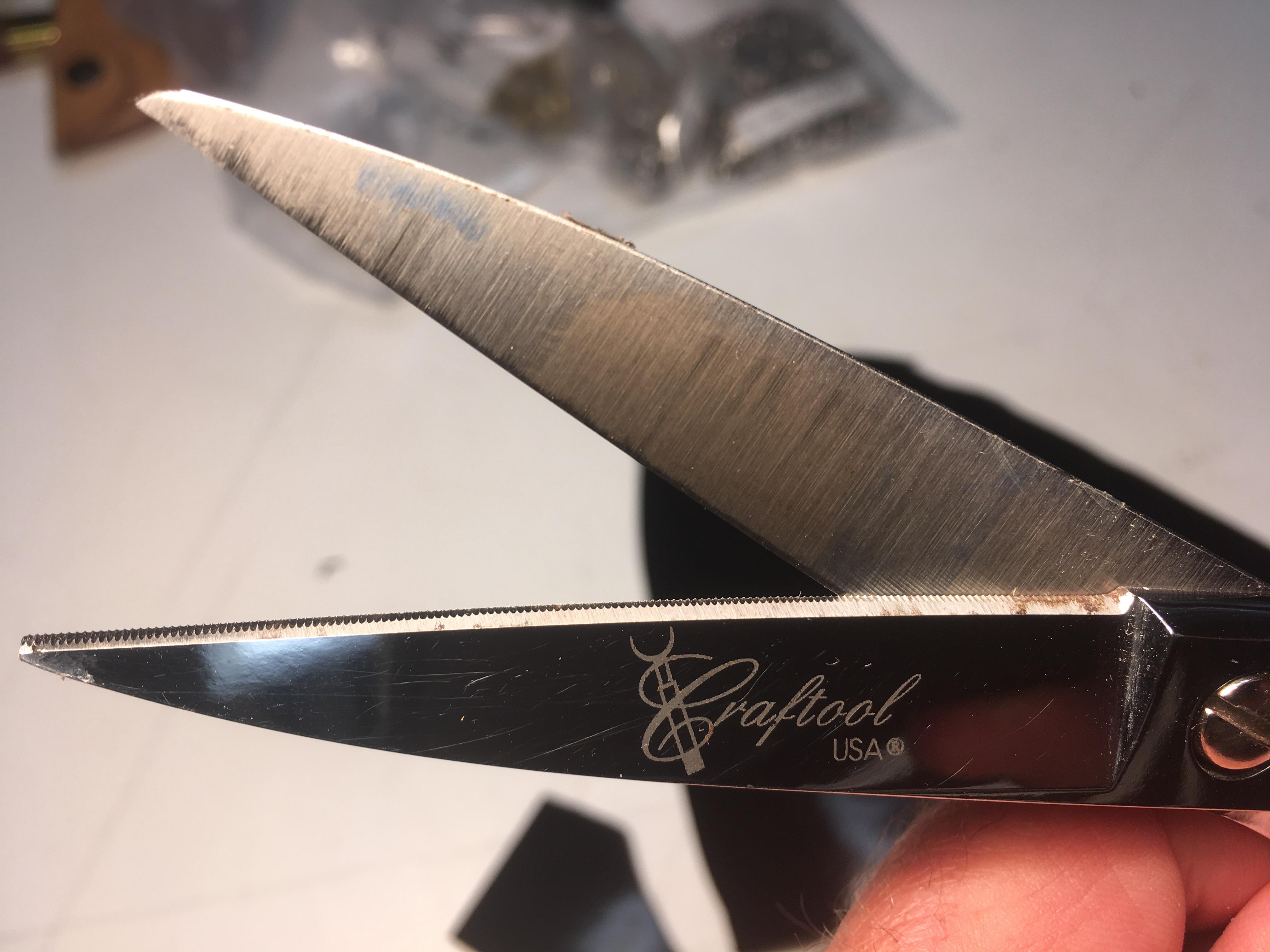-
Posts
1,281 -
Joined
-
Last visited
Content Type
Profiles
Forums
Events
Blogs
Gallery
Everything posted by TomE
-
I got tired of my stretchy work belt and phone clips that break, so I made a couple of accessories for my day job as assistant mucker at Maefield Farm. The belt is made from 10 oz Hermann Oak chocolate harness leather with a liner. The phone case is made from 5-6 oz "oil tanned" leather from the SB Foot Tanning Co. The case was constructed around a block of closed cell foam, glued and sewn at 10 stitches per inch. The edges of the belt and case are sealed with beeswax.
-
I think you could adapt the method for laced reins to make this pattern. Would decrease the spacing between holes and perhaps use a lacing chisel (or a sharpened screwdriver), instead of a round hole punch, on the outer holes of the pattern. This would help to keep the lace lying flat. I'd make lace out of the leather of your choice, about 1/8" wide of 5 oz thickness. I would use bridle leather for some stiffness and tap it with a polished hammer to set the shape. Here's how laced reins are laced:
-
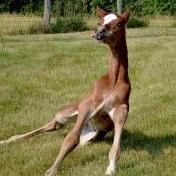
New pistol, new holster
TomE replied to Thadrick's topic in Gun Holsters, Rifle Slings and Knife Sheathes
Very pretty! I Iike the colors and the craftsmanship is first rate. -
I regularly sew padded straps as shown in your picture using TSC-441 clone (Cobra Class 4). I typically sew 1-2 layers of 9-10 oz bridle leather over a pad of 1/8" neoprene wrapped with 4-5 oz chrome tanned leather. The pad turns out fine with a #25 needle and #277 thread. I make English tack as well, and prefer to hand sew bridles, reins, and most repairs. I use the 441 machine mainly for halters, and it did a good job sewing new shearling on a surcingle (8-9 oz strap).
-
Beiler's lists the lengths and widths of their bag punches in their catalog. Probably standard widths. Beveling the edge of the slot with a fine edger on the flesh side can help fit the tongue in the slot.
-

Looking for a replacement for discontinued Denver Side
TomE replied to mjpaisley's topic in All About Leather
Hide house has a 4 oz FOC (free of chrome) leather in pistachio, a slightly darker green. https://www.hidehouse.com/Leather/Aspen-Cow-Full-Grain-Semi-Aniline-Finish-AS15-P.asp As best I can tell, this is similar to a chrome tanned hide but using other minerals in place of chromium. -
That's a neat job of installing zippers. Looks very professional.
-

Problem using a TandyPro Deluxe Leather Splitter
TomE replied to Coloradoguy's topic in How Do I Do That?
If you can't find a local sharpening service, you might check with Leather Machine Co. They offer sharpening of the hollow ground blade for their Class 14 splitter. @bruce johnson sharpens blades for Osborne manual splitters and might be able to help you out. -
I think I have the same Chinese skiving knife. It's a winner for the price. Another skiving tool I use often is this small round knife from Abbey England. The blade is 68mm = 2-5/8" wide. It holds an edge and is handy for skiving and for cutting egg points/English points on strap ends.
-

Micro Copper Burr Rivets - A Solution
TomE replied to Stagesmith's topic in Hardware and Accessories
Innovative solution and good looking results. Thanks for posting this information. -

Problem using a TandyPro Deluxe Leather Splitter
TomE replied to Coloradoguy's topic in How Do I Do That?
My older Tandy Pro splitter doesn't have the additional depth locking screws on both ends of the roller. It seems that the strap is getting pinched on either edge and drawn up towards the blade in the middle. I don't have an idea why that would happen. Does this occur when using different parts of the blade? Have you tested different leathers of varying thickness/temper? Is the roller centered on the edge of the blade? Also, I don't understand the need for the 2x4 clamping the strap. When I split straps I don't have any pressure on the strap entering the splitter. I am careful to pull the strap through at a consistent angle, slightly lower than horizontal. -
That's an interesting point, Chuck. It seems the ability to use a sewing awl is a dying art, driven in part by the ability to market expensive punches and irons. I've been an advocate for the efficiency, versatility and esthetics of awl sewing - holes always line up, can sew odd shapes that are difficult to punch, the hole size matches the thread. I'll add strength of the stitch to the list. Strength is tested on a regular basis with horse tack. I haven't seen many examples of failed stitching. It's usually the leather breaking where it wraps around hardware. I have seen linen thread rotted out after many years.
-
Beautiful workmanship! The white stitching really shows it off.
-

New Tool Idea - Large Leather Shears - Should I make these for sale?
TomE replied to Stagesmith's topic in Leather Tools
I have 9” Craftool serrated scissors that I really like for trimming light weight leathers. Tandy doesn’t sell them anymore, so yes, I think there’s a market your serrated scissors. -
This thread addresses your question about a walking foot. I did a Google search "site leatherworker.net Singer 44-10" and found a lot of information.
-
Not really a shop accident, but for the last 17 years my "shop" has been horse barns with broodmares and youngsters. We had purchased a mare that hadn't been handled much. I getting to know her and trimming a hind foot when she decided to jump through/over me. She didn't make it and broke 3 long bones in my foot, although I didn't know it at the time. A veterinarian friend stopped by the next day and offered to take some x-rays. He determined the foot was broken. I made an appointment with a foot/ankle surgeon and took the x-rays along. During the appointment a thunderstorm knocked out the power and they said I'd need to come back for x-rays. I told them I happened to have my own x-rays in my backpack. The surgeon was impressed and said he gets x-rays from podiatrists that don't even look like a foot. I told him that equine vets have experience radiographing patients that are less cooperative than me. So he put me in a walking cast and sent me on my way. Twelve years later the mare and I are like two flies on a donkey's ass. She produced a pretty black filly this year and is pregnant for next year's foal. She's in her late teens and this might be her last foal. She will retire here as a babysitter of weanling foals.
-
Might contact Bob Klenda about his batwing pattern #44. https://www.klendasaddlery.com/patterns.html He's a regular contributor to the Leather Crafters and Saddlers Journal, and recently published a book on making chinks and chaps. https://leathercraftersjournal.com/product/from-my-bench-to-yours-a-handbook-for-making-chapschinksarmitas/
-
That's a handsome belt! I like the transition of the decorative stitching, continuing to the ends of the belt.
-
I use a 3 lb Osborne maul for most every drive punch and setter. It is nicely balanced making it easier to control the force.
-
@bruce johnson has overstitch wheels in various sizes.
-

Tutorial, replacing zippers in riding boots.
TomE replied to Mulesaw's topic in Shoes, Boots, Sandals and Moccassins
Thank you for all the tips, Jonas. I've been buying a roll of continuous zipper and cutting to length then adding stops. With the Vislon/formed tooth zippers I've seen videos from Sailrite where they melt the teeth (using a heated nail or similar) to create stops. I've raised my prices for zipper replacements as I gain more experience and demand grows. I am becoming friends with my patcher as I use it more. Has a different rhythm than the compound walking foot machines. We have a visiting horse who wears rubber bell boots continuously (has an undiagnosed skin condition that is aggrevated by sunlight) and he rips the rear boots regularly. I've been patching them with 4 oz leather - they have a hook and loop closure - this seems to last and saves quite a bit of money. -

Leather covered bit, replacement of the leather
TomE replied to Mulesaw's topic in Saddle and Tack Accessory Items
Good looking stitching, Jonas. Stohlman's hand sewing book shows a baseball stitch using one needle. I couldn't get that method to look tidy, so I am using 2 needles now. Looks like you do the same. -

Tutorial, replacing zippers in riding boots.
TomE replied to Mulesaw's topic in Shoes, Boots, Sandals and Moccassins
Your tutorial is a welcome resource, Jonas. I was sewing from the top, around the bottom, and back up the other side. That was causing lots of problems with the lining and zipper moving, and breaking needles crossing the zipper to sew up the other side. I was putting a metal bottom stop on the zipper and have stopped doing that. Will try your suggestions at my earliest opportunity. Thanks a lot! PS How do you treat the top of the zipper? Do you add top stops? Do you remove teeth and fold the tape back on itself? -
It's been a few years since I priced pricking irons. These particular irons are well made and should last a lifetime for marking, not punching, holes. An overstitch wheel will do the job as well.



